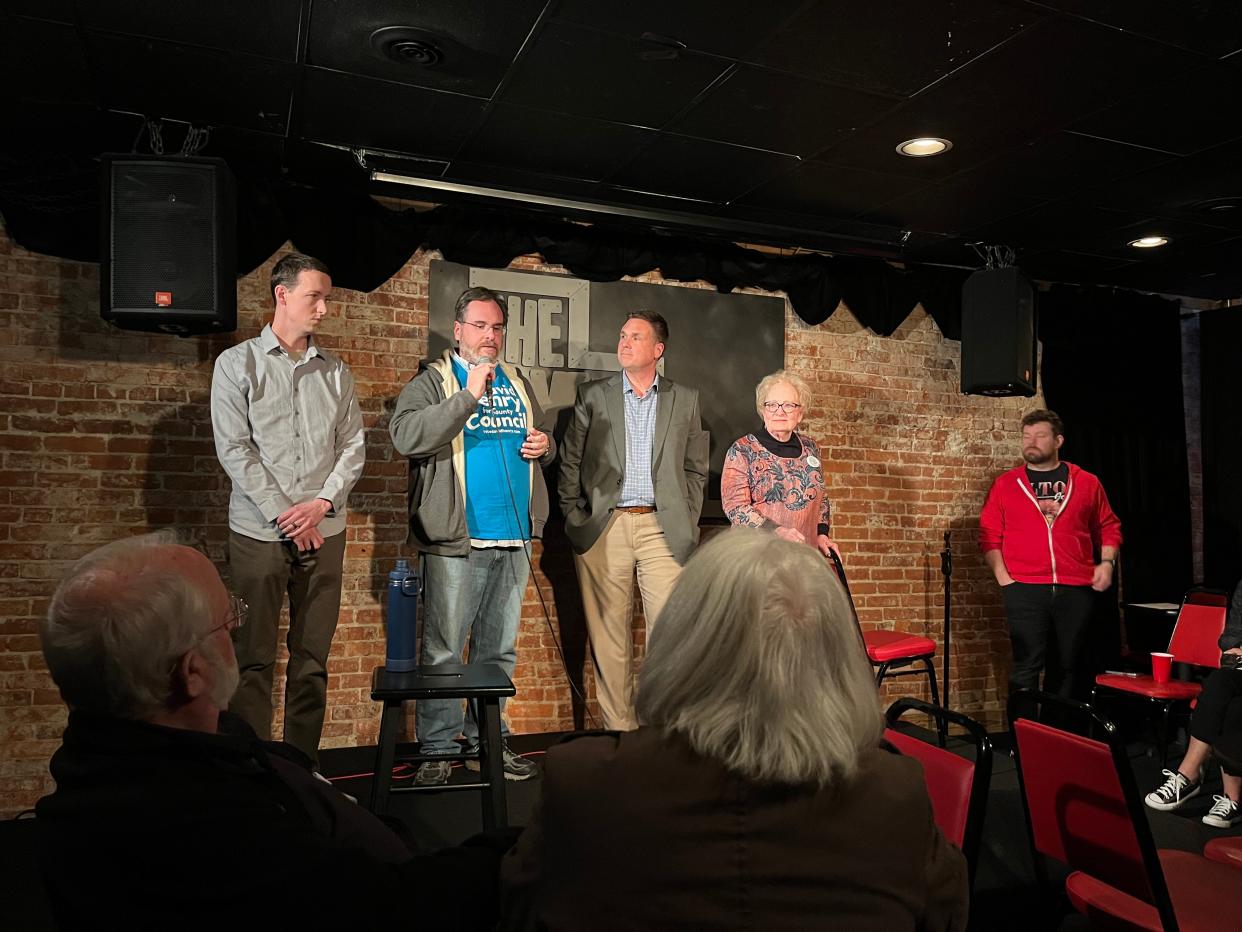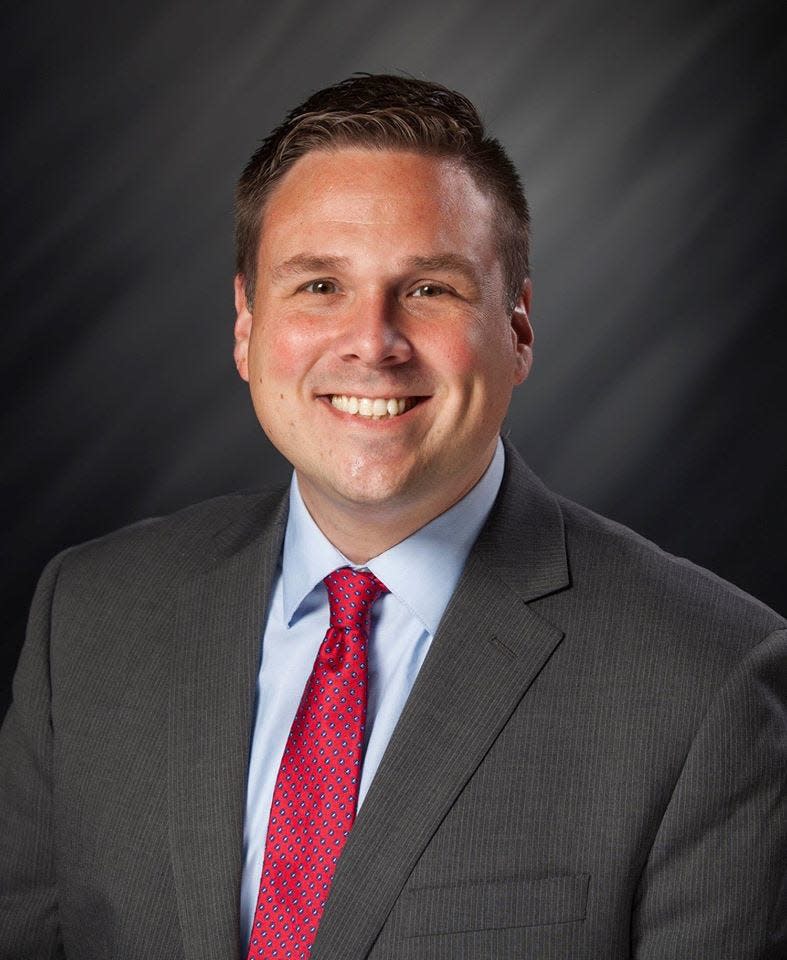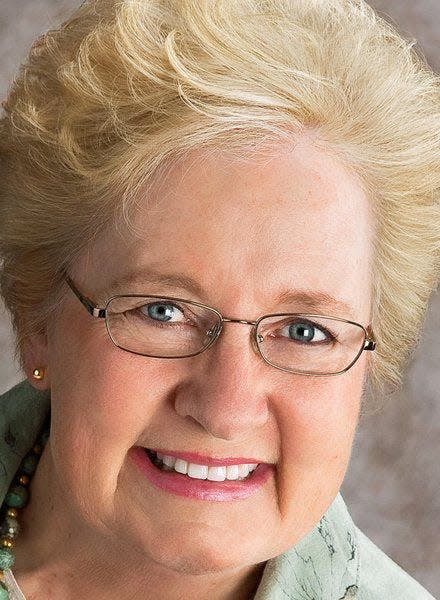Jail, finances, employee retention: County council candidates answer questions.

Editor's note: This is part of a series of articles about the primary election.
Monroe County voters get to choose three county council members this year. Primary voters on the Democratic side will get to select three members from the four candidates. No Republican has filed.
Early voting has begun. The primary election is on May 7.
The county council has control over the county's fiscal affairs, including the setting of budgets. The council has seven members. Four of the seats are not up for election.
All voters in Monroe County — including those in the cities — will get to choose three from the following four candidates in the primary, so long as they choose a Democratic Party ballot. The candidates are listed in alphabetical order by last name.
Competitive election: Commissioners, council members to be tested in primary

Name: Matt Caldie
Date of birth: 4/26/1988
Family (marital status/children): Married / with two cats
How long have you lived in Monroe County: Since 2006
Occupation: Business Coordinator at the IU Law Library
Education: Bachelor of Arts, Political Science/Philosophy from IU Bloomington
Q: Why are you running for county council? What would you bring to the job that your opponents wouldn’t?
Caldie: I see the difficult issues the County is facing, and I want to be a part of solving them. I have a blue-collar background – I have worked physically demanding jobs, often for low wages. When I was a renter, I lived with roommates and moved frequently to afford living in our expensive community. I know firsthand how the types of employment and housing choices in Monroe County can make people feel like there are no good options for them. These experiences – and my connections with others experiencing them – allow me to speak to the struggles of many Monroe County residents who may not feel heard by government. I also bring robust environmental credentials, serving in my fourth consecutive term on the Bloomington Environmental Commission, currently as Vice Chair.
Q: Where should the community build the new jail? How much would that cost? How would you fund it?
Caldie: The new jail needs to be served by public transit and built as close as possible to existing services, offices, and courts. I look forward to working collaboratively with all stakeholders – such as county, city, local organizations, and advocacy groups – to find a location that fits these parameters and is fiscally feasible. The overall cost will depend on many factors, including whether land must be purchased, building size, and the number of beds. Once the price tag becomes clearer, the funding picture should come into focus as well. The County’s share of the Economic Development Local Income Tax passed by the city council in 2022 should go a long way toward covering the cost of the new jail. Bonding could also be utilized if needed.
Q: Which additional support services — mental health, substance abuse, etc. — would you propose be included in the new jail/justice center? How would you fund them?
Caldie: Providing incarcerated individuals with mental health and substance use counseling, along with greater reentry support, is necessary to break the cycle of mental health crisis, substance use disorder, homelessness, incarceration, and recidivism. These services may be costly, but they reflect our community’s values and end up reducing repeat incarceration expenses in the future. Costs for providing these services could vary significantly depending on which services are provided by volunteers, non-profits, or full-time staff. Staffing is the highest operational cost for a jail, and it is currently very difficult to estimate required staff numbers without knowing design details or maximum occupancy figures. In the immediate future, this seems like an appropriate use for opioid settlement funds. Looking long-term, building the jail adjacent to these support services and continuing to support diversion programs will also help to reduce costs.
Q: The Government Finance Officers Association recommends governmental units keep reserves of at least two months worth of spending, or 16.7% of annual spending. According to Gateway Indiana, the county’s general fund at the end of 2023 had a reserve of 59%, or $25.5 million. Would you recommend spending any of these reserves? If not, why not? If so, how much and on what?
Caldie: I’m grateful that the council has built up healthy reserves. Much like a personal savings account, it allows for flexibility in budgeting. We could be saving for expensive planned projects on the horizon while simultaneously having money set aside in case of unexpected expenses. At the same time, taxpayer money should be put to use to deliver quality infrastructure and services to our community. I look forward to working with my fellow council members to determine the most prudent way to spend these funds. Some possibilities include offsetting costs of jail construction or addressing substantial deferred maintenance in county transportation infrastructure and parks. In the meantime, we need to utilize American Rescue Plan Act dollars and Inflation Reduction Act dollars to the largest extent that we are able, to capitalize on the availability of federal funds for improving Monroe County.
Q: County employees begged for raises last year. Many county departments have been dealing with significant turnover, including the health department and clerk’s office. What specific steps would you take to tackle those challenges?
Caldie: One major challenge for the county council is that we can’t fund everything we would like. There are multiple expensive projects on the horizon, but we can’t afford to lose sight of the needs of our county employees, who are the foundation of what we do. I’ve spoken with clerk Nicole Browne, so I know the struggles in her department. She recruits new employees, but once they’ve acquired skills and job experience, they leave to work for other departments – often the courts, which pay several thousand dollars more. When officials tell you the problems they’re experiencing and how difficult it makes their job, we need to listen and prioritize improving their situation. We also need to review pay scales annually in order to ensure that county employees’ salaries keep up with rising costs of living.

Name: Trent Deckard
Date of birth: 11/14/1977
Family(marital status/children): Married to Kyla Cox Deckard, father of two daughters
How long have you lived in Monroe County: since 1977, with a few years away during college and briefly after
Occupation: Lecturer of Business Communication, Kelley School of Business, Indiana University
Education: PhD-in progress at Saint Mary-of-the-Woods College, MA in Applied Communication at IU, Bachelors in Political Science and Criminal Justice at Ball State
Q: Why are you running for county council? What would you bring to the job that your opponents wouldn’t?
Deckard: I am running because I believe we have many projects that need experienced public servants who understand our needs and people. I come from a nine-generation Monroe County family and bring 20 years of experience at the federal, state, and local levels of government ranging from time as a congressional aide to running a state agency. I believe elected officials at every level of government can work together, and that when they do, they can get good results for the constituents they serve. I believe local governments can set a strong example in this way while addressing housing affordability and responding to the needs of our workforce and most vulnerable populations. I bring a positive demeanor for the work ahead and I think that quality is why my council colleagues have elected me to leadership for the last three years.
Q: Where should the community build the new jail? How much would that cost? How would you fund it?
Deckard: A new correctional center should be built collaboratively with officials and departments in our justice system and agencies and constituency groups that assist those in the system. While ultimately a decision for this location legally belongs to the Monroe County Commissioners, my wish is that they will collaboratively work with the above entities to find a location with proximity to services. If such a location has a need for a service, such as public transportation, all public entities should work quickly to remedy that situation. I also think such a correctional center should be co-located with as many justice system entities as possible. We need greater specifications for square footage, design, and need to determine cost. To pay for this, the county council will problem-solve as we know how to do: look at available funds, consider options, and respond accordingly while considering responsible approaches on behalf of taxpayers.
Q: Which additional support services — mental health, substance abuse, etc. — would you propose be included in the new jail/justice center? How would you fund them?
Deckard: I support continued mental health and substance use services within the existing correction center as well as a new facility. We are in talks with the sheriff now about how that will look under his vision and leadership. For the county council, it will mean determining what we can afford and sorting through that consideration among others. I also believe that these services do not need to be exclusively within the confines of a correction center. We can work proactively with community partners, such as Centerstone and the Indiana Recovery Alliance, to determine other outside entities where this could be possible. This will take a good amount of work and once again, the county council will problem solve to determine how to best fund. It will likely take a mix of grant dollars, public revenue, and other agencies to get this done, but we have a long history doing that.
Q: The Government Finance Officers Association recommends governmental units keep reserves of at least two months worth of spending, or 16.7% of annual spending. According to Gateway Indiana, the county’s general fund at the end of 2023 had a reserve of 59%, or $25.5 million. Would you recommend spending any of these reserves? If not, why not? If so, how much and on what?
Deckard: My experience as a state agency head and six-year council member tells me that the two-months reserve tends to a bit shy in meeting our needs. Generally, I believe we should maintain about 30% (4 months) of reserves for additional needs that come up beyond the adopted budget as they have done each year I served. Of note, at our Tuesday, April 23 meeting, we will consider one-such additional appropriation to fund additional medical contract needs for our correctional center. This can happen throughout the year and sometimes unexpectedly. We are also permitted to transfer up to 10% of our budget to Rainy Day funds and I suspect we will. We don’t know potential costs of annexation and having good reserves was important during the pandemic, so maintaining a healthy reserve is wise. Additionally, we have spent from reserves to do additional paving and this was a good move.
Q: County employees begged for raises last year. Many county departments have been dealing with significant turnover, including the health department and clerk’s office. What specific steps would you take to tackle those challenges?
Deckard: I truly appreciate county employees who provide the crucial services our public needs daily. I was raised as a son of a county employee and I know the work they do and the difficulties with salaries we’ve had in the past. Our people are second to none and we should be supportive of them. That is why it was easy last year to support an 8.5% cost of living adjustment to salaries for the budget. We also went beyond that to adjust up some of the bottom rungs of our salary grid and make those payroll lines more realistic. This work benefited the clerk’s office directly and we went beyond that action this year to raise absentee worker pay. A 20% increase to law enforcement two years ago helped with retention of our first responders as well as correction officers. We will continue to work to be competitive with wages.
Name: David G. Henry
Date of birth: June 28, 1980
Family (marital status/children): Married, 3 Children
How long have you lived in Monroe County: 22 years, with a few years away in Washington, DC.
Occupation: Government Project Management Consulting; Teaching Faculty, IU O'Neill School of Public and Environmental Affairs
Education: MPA, Local Government Administration, IU. BA, Political Science, Baldwin Wallace University
Q: Why are you running for county council? What would you bring to the job that your opponents wouldn’t?
Henry: I'm running to get stuff done in our county. I am a government consultant by trade. With Geoff McKim's retirement from Council, we need experienced leadership that can pick right up on the hard fiscal decisions - like funding a restorative criminal justice system, fixing aging infrastructure, funding economic development projects, and supporting our workforce while funding our values. That means thinking through chronic job, poverty, and housing needs when we make tax decisions, and the disparate impacts. I bring over 20 years experience in and out of government service. As chair of our local Democratic party, I have a working rapport with every elected official that I can put to work on day one. I would be the only former county employee serving on Council, having worked in our county health department early in my career. I bring first hand knowledge of the job struggles our county workforce faces.
Q: Where should the community build the new jail? How much would that cost? How would you fund it?
Henry: Hopefully, the justice center location is decided by inauguration day. If not, I believe as many do that the jail is but one piece of the criminal justice puzzle, that requires close proximity to the lifelines for mental health, probation, access to public defenders, transportation for families, and courts. I support a campus close to and with easy access to those services. Early estimates are grossly underinflated. In 2008, the estimate for a new facility was $47 million, and that was absent 21st Century values of restorative justice. Excavation costs could make this a 9-figure facility. We need the full requirements - the must haves - before anyone can confidently assume a final cost. The real cost is in the fact we have kicked this can down the road nearly 20 years. Funding comes by a mix of bonds and sale of county parcels before I'd raise the public safety LIT.
Q: Which additional support services — mental health, substance abuse, etc. — would you propose be included in the new jail/justice center? How would you fund them?
Henry: These aren't "additional" services - they are requirements for a holistic criminal justice solution. The challenge is working with the expertise in county government, the non-profit community, and the criminal justice community to continue to find and win grants and programs to provide and fund that support system. I do believe, as a former county health employee, that many of these programs are well-suited for non-law enforcement interventions. We need more public health in the mental health conversation - requiring leadership that understands how to cross "silos" in government and build those multi-department projects. That approach has been my 20 years in government and consulting, and the positive insight I'll bring to Council's deliberations about funding a whole solution instead of focusing solely on a jail building.
Q: The Government Finance Officers Association recommends governmental units keep reserves of at least two months worth of spending, or 16.7% of annual spending. According to Gateway Indiana, the county’s general fund at the end of 2023 had a reserve of 59%, or $25.5 million. Would you recommend spending any of these reserves? If not, why not? If so, how much and on what?
Henry: Council deserves credit for its robust rainy day fund, pivotal during the pandemic. However, effective investment requires using cash flow. We should aim for reserves above the minimum threshold but avoid hoarding resources needed for community development. Reserves shouldn't be estimated at the year-end high-point of state revenue, but at its lowest point before periodic disbursement, capped at 20% — slightly above the 16.7% reserve —to enhance cash flow for obligations, road repairs, and capital improvements. Tax revenue should prioritize economic development, boosting the county workforce's wages and benefits like paid maternity leave. Funds should also support ambitious projects such as addressing homelessness and transitioning to hybrid fleets. With my emergency management background, I stress maintaining reserves for disaster relief, whether Derecho or Stinesville's recent tornado seasons. We should prioritize using reserves above the minimum threshold for vital community development.
Q: County employees begged for raises last year. Many county departments have been dealing with significant turnover, including the health department and clerk’s office. What specific steps would you take to tackle those challenges?
Henry: I am the only candidate who has been a county employee and will be a voice for them. I also earned a professional fellowship in HR management with the District of Columbia after county employment. While the county contracts HR consulting, my experience in a major city offers valuable insights. I understand the challenge of motivating a workforce unable to afford living where they serve, having once resided in equity housing while working for the county myself. I advocate for a broader employee satisfaction survey and performance-based reward programs, as I believe in servant leadership that supports the workforce that delivers for us. Windfalls, such as the $14 million in revenue from the State should be proactively allocated to enhance compensation, including paid maternity leave and childcare, especially as we know there is disproportionate impact on women and communities of color. Improving childcare benefits tailored to the county workforce is essential.

Name: Cheryl Munson
Date of birth: 08/08/1944
Family (marital status/children): married/2 adult children, 4 grandchildren
How long have you lived in Monroe County: since 1971
Occupation: archaeologist (retired IU Research Scientist)
Education: BA, University of Arizona, 1965 (anthropology, geology); MA, University of Illinois , 1971 (anthropology, archaeology)
Q: Why are you running for county council? What would you bring to the job that your opponents wouldn’t?
Munson: After more than 50 years in this beautiful community, I have a perspective enriched with longevity and inspired by working with others on diverse missions and projects. On the council I keep in mind that the decisions we make now shape the future for our children and grandchildren. The council works best by carefully stewarding our government finances – the taxes our residents pay – to provide the services and amenities that our community needs and values From my professional and community work, I know our city, towns, and rural areas, which gives me a county-wide view and a good sense of where we are strong, where fragile, and where the council needs to lead. Combining my 12 years of experience on the council with my previous 16 years on the Indian Creek Township Board lets me offer county residents a depth of collaborative work, problem-solving, decision-making, and budget-crafting that is unmatched by others.
Q: Where should the community build the new jail? How much would that cost? How would you fund it?
Munson: Cost and funding – from bonds and local income taxes (EDLIT, PSLIT, other) – must follow decisions on location. I would prefer to build the Justice Center at the old hospital site in the Hopewell complex because this would keep the jail near public transportation and community services (including mental health), which are available nearby. A trade of the county’s Thompson (RCA) property, which is well suited for residential development, for the city’s old hospital site that is part of Hopewell would keep the jail downtown. (Imagine a “Hopewell Justice Center” and what that name would mean to the people working and incarcerated there.) Alternatively, building the Justice Center near the I-69/SR 46 junction (North Park) will require the construction of facilities for justice-related departments – courts, probation, prosecutor, and public defender, which will be expensive and leave a void in the city that will greatly change the character of downtown Bloomington.
Q: Which additional support services — mental health, substance abuse, etc. — would you propose be included in the new jail/justice center? How would you fund them?
Munson: I believe the two key support services are those for mental health and substance use disorders because a large proportion of the incarcerated population is affected by one or both conditions. Facilities for these services can be located adjacent to the new jail. In addition, related treatment and support should be available outside the Justice Center as an alternative to incarceration when appropriate. In this way, people may receive mental health or substance use treatments either before encountering the justice system or in lieu of jail. Ideally, providing a dual stream of services (within the justice campus and in the community) would help reduce recidivism for those incarcerated and also decrease arrests, which in both cases can help lower the size of the jail population. Expenses for substance use disorders and mental health treatments can be funded, at least in part, through Opioid Settlement funding if the council approves.
Q: The Government Finance Officers Association recommends governmental units keep reserves of at least two months worth of spending, or 16.7% of annual spending. According to Gateway Indiana, the county’s general fund at the end of 2023 had a reserve of 59%, or $25.5 million. Would you recommend spending any of these reserves? If not, why not? If so, how much and on what?
Munson: Information about the county’s budget and projected expenses, among other reports, is available to the public through the state’s Gateway system. For the 2024 budget, the report shows various budgets with the General fund being most relevant. It lists the amount of $44,660,019 for 2024, making the reserve 57.2% of projected 2024 expenses The council has regularly kept about 25-30% of funds in reserves to cover unplanned and one-time expenses, as well as revenue shortfalls. For 2024, the council spent part of the general fund’s reserves to give county employees raises, and I expect we will pay some costs for the new jail from reserves. Additionally, the council approved a one-time expenditure of 1.5 million dollars from reserves to use as local cost-share to match the state’s Community Crossings grant for the same amount, significantly increasing the paving of county roads. I supported both expenditures.
Q: County employees begged for raises last year. Many county departments have been dealing with significant turnover, including the health department and clerk’s office. What specific steps would you take to tackle those challenges?
Munson: Council members are aware of the turnover in some departments, primarily as a result of losing valued employees to positions elsewhere that provide higher salaries. At the same time, it is important to treat our employees equitably and to correct misapplied job classifications. Salaries are tied to job classes, not to individual employees. When I learned that our probation department staff, whose salaries are set by the state, did not benefit from the cost-of-living raises afforded other county employees, I proposed and won the Council’s support for equitable benefits for our probation officers. I also supported an extraordinary cost-of-living raise of 8.5% for all employees for the current fiscal year, plus an additional $0.55 per hour for the lowest-paid employees. The 8.5% raise was more than double the 2024 state-mandated budget growth rate (4%). These important raises required considerable collaboration and will continue to require careful management going forward.
Boris Ladwig can be reached at bladwig@heraldt.com.
This article originally appeared on The Herald-Times: Jail, finances, employee pay: County council hopefuls answer questions.
